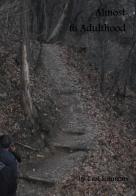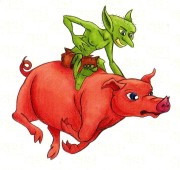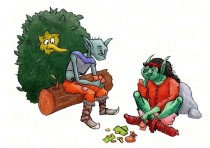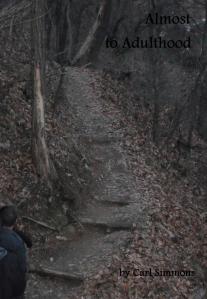An excerpt from The Servant and the Scepter:
The next day Karillus reported to Captain Roehm as usual, but the knight redirected him to the West Tower, where Alberic was serving his duty. With uncertain curiosity Karillus ascended the long spiral staircase leading to the single room at the top of the tower, where the mages kept their vigil. Or whatever they did—none knew, save for perhaps the king. Alberic himself seemed to be merely reclining in a chair when Karillus entered the room, and in such stillness that Karillus could not at first tell whether the mage was resting, asleep, or even dead.
“The prince came to see me the day before yesterday,” creaked Alberic’s voice. He stared levelly across the room at Karillus, twirling the three hairs that hung from the left side of his jaw and which accounted for his beard. “It seems his men could not be relied upon to give him a straight answer to a question he posed them…”
The mage lapsed into silence, staring, twirling. “He came to you,” Karillus prompted.
“I am one man who does not fear his reprisal,” grated the voice of the withered mage.
“He asked you if he had done you any evil,” guessed Karillus.
“No,” Alberic growled. “He knows the answer to that. No, he asked me if he had done any evil to his knights. Seemed to think I would know, as if I see everything. As if I watch everything.”
“You had no answer for him then?”
“I had an answer,” the wizened wizard’s eyes widened. And whitened. “There are many deeds a prince does that are known by all. Or by all, it seems, except for him.”
His eyes again normal, Alberic stared again in silence at the man who had challenged the prince.
“And of the deed done against you,” Karillus attempted to draw out this slow narrator. “Did he ask your forgiveness?”
Hefting himself up by his staff, Alberic the Spent rose from his chair and proceeded toward Karillus, coming within a foot of Karillus before answering. “He did not,” croaked the mage. “Priest. Did you really think he would?”
“I had hoped,” Karillus let his shoulders fall. “Something. Something important enough to explain you summoning me here.”
“Hm,” responded the mage, turning away, but not quickly enough to conceal the smile that crept into his eyes and wrinkled face. “Something,” he acknowledged on his way to the staircase that led to the roof.
Karillus followed, coming out onto the flat marble roof and immediately becoming dizzy at the astonishing height. From here he could take in the whole of the great city of Marin, the docks and the bay on one side, and an expanse of farmland on the other. So this is what the birds see, thought Karillus. Amazing.
“The birds,” Alberic could barely be heard in the wind, “are our eyes afar. Awareness is our first protection, you know.” Turning to Karillus, the wizard pointed out a hawk in the distance. “Call to him.”
“Call?”
“Call,” the mage insisted.
“I cannot.”
“Watch,” Alberic approached Karillus. “Listen. Sense. Be aware.” The mage reached up and touched Karillus’s head, then reached into his mind.
“Ah!” started Karillus, losing his balance and falling to one knee. In the distance, the hawk shrieked, and turned toward them.
“Now,” Alberic whispered into Karillus’s ear, “call him.”
Karillus searched his mind for the point Alberic had touched. It was as if the mage had moved a muscle of his that he didn’t even know he had possessed. But he knew now; he could still feel the tingling in his mind. But could he activate the power himself?
Alberic the Spent watched as Karillus extended his arm, and smiled as the hawk perched itself there. “Now,” he whispered again, “sense. Its eyes; your eyes.”
The bird launched back into the air, and streamed toward the Sea of Yuhn. “I’m flying,” Karillus gasped. “Flying.”
“The bird is flying,” Alberic reminded him. “You see through its eyes. But enough.”
“It’s beautiful,” breathed Karillus.
“Enough!” snapped the mage, and Karillus’s vision was dispelled. Suddenly exhausted, he fell upon his hands and gasped for air.
“Quite a labor, no?” iterated the mage. “Even on this tower. But it shall become easier, with practice. Not too much practice, though.”
“Why…” exhaled Karillus as Alberic started toward the staircase. “Why have you shown me this?”
“It is a terrible thing for a powerful man to be an evil one,” asserted the mage. “Or for a powerful people, to be evil. You spoke of this to the captain, did you not? You told him what strength is used for; when a good man is strong, he pits that strength against the evil.
“You are strong, Karillus Urill Vrinn Khan. Stronger than most. And you would oppose evil,” he explained, even as Karillus passed out.
…
Training with Captain Roehm had been demanding, but Karillus thought it slight exertion compared to training with the mage Alberic. Five minutes spent practicing one of his arts left him as exhausted as five hours of sword exercises. At first, that is.
“You see why swordsmen do not use magic to help them,” said Alberic as Karillus concentrated upon an unlit candle. “At least, men do not,” he continued. “There are some elves who can manage. You see, the art which the elves discovered draws its power from one’s own life force. You spend yourself with each use. Overspend yourself, and you do terrible damage to your life. That is why we limit our practice: just enough to increase your strength, your endurance, but never enough to drain your life.
“This tower,” continued Alberic as the end of the candle wick began burning, “is built to make use of the art less difficult. When you get stronger, we will begin to practice elsewhere.” The candle fire continued to grow, well beyond what the candle should have been able to support. “You’re feeding it too much,” scolded Alberic, placing a glass bowl over the candle. Deprived of air, the flame went out.
“I can’t relight it,” realized Karillus after a few moments trying.
“Of course not,” coughed his instructor. “The Art of the Elves does not violate the laws of nature. Fire requires air to burn. No air, no fire—no matter how much magical energy you spend,” he continued as he hobbled over to the bookcase. Selecting a red-handled scroll from the top shelf, he returned to Karillus and handed it to him. “So long as the scrolls stay in this room, you may read any one of them. Sit for a while, then, and study.”
Karillus hesitated to open the scroll he had been handed. “These contain spells?” he inquired.
“Folly again,” grumped Alberic. “Was it a ‘spell’ that called the bird? A ‘spell’ that ignited the candle? There are no such things in the Natural Art. It is an Art of Wonder. You learn by instruction, and exercise—like Roehm’s pupils learn from him.”
“Then what—”
“What you hold in your hands is a treatise on fire,” divulged the learned mage. “Useful knowledge for one who wants to command fire. In there you would learn what I declared to you, that fire requires air to burn, and you will learn many other things besides. Read it.”
Karillus looked down at the scroll, then back up at Alberic to ask him another question, but the mage’s still posture and stern eyes were answer enough. Sighing, Karillus sat down upon the stone floor and opened the scroll. Then he looked up at Alberic again, but the old man stood leaning upon his staff in the same rigid posture, only his stern gaze had followed Karillus to the floor.
Turning his eyes back to the scroll, Karillus began reading about fire.





